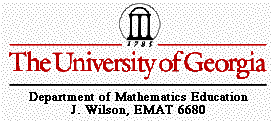
Final Project for Kanita DuCloux
Part A: I will consider any triangle
ABC. Select a point P inside the triangle and draw lines AP, BP,
and CP extended to their intersections with the opposite sides
in points D, E, and F respectively. Then, explore (AF)(BD)EC)
and (FB)(DC)(EA) for various triangles and various locations of
P.
Observe the triangle below. (AF)(BD)EC)
= (FB)(DC)(EA). Click on triangle to
construct a triangle like the one below and drag a point to see
that the two products are always equal.

Part B: Prove (AF)(BD)EC)
= (FB)(DC)(EA)
To prove this, I need to draw some
parallel lines to produce similar triangles and consider the ratio
 and generalize to a point P outside
the triangle.
and generalize to a point P outside
the triangle.
Draw lines (BY and CY) parallel to
AD. Now, triangles BPD and BXC are similar by AA AND


We also have triangles CPD similar
to triangle CYB and thus


Taking the proportions above, we have
 ,
,  yields, (BD)(XC) = (BC)(PD) and (DC)(YB)
= (PD)(BC). By substitution, we get
(BD)(XC) = (DC)(YB) or
yields, (BD)(XC) = (BC)(PD) and (DC)(YB)
= (PD)(BC). By substitution, we get
(BD)(XC) = (DC)(YB) or  .
.
Next we have, triangle EXC similar
to triangle EPA by AA. Going through a similar process, yields


We also have triangle FPA similar to
triangle FYB by AA and


Let's revisit our proportions:
 ,
, ,
,
 Everything on the right-hand side of
the equation cancels out and therefore equals 1. So,
Everything on the right-hand side of
the equation cancels out and therefore equals 1. So,

Can this be generalized so that P is
outside of the triangle? Observe the pictures below. There are
a lot of lines in the pictures but look at the distances. It appears
that the same is true if the point P is outside.
Then, click outside
to try it yourself.


Part C: Show that when P is inside triangle ABC, the ratio
of the areas of triangle ABC and triangle DEF is always greater
than or equal to 4. When is it equal to 4?
Observe the following picture. Then,
click on area and drag a vertex to see
what happens.

When is the ratio equal to 4? Look
and see. Point P is the centroid.

return










